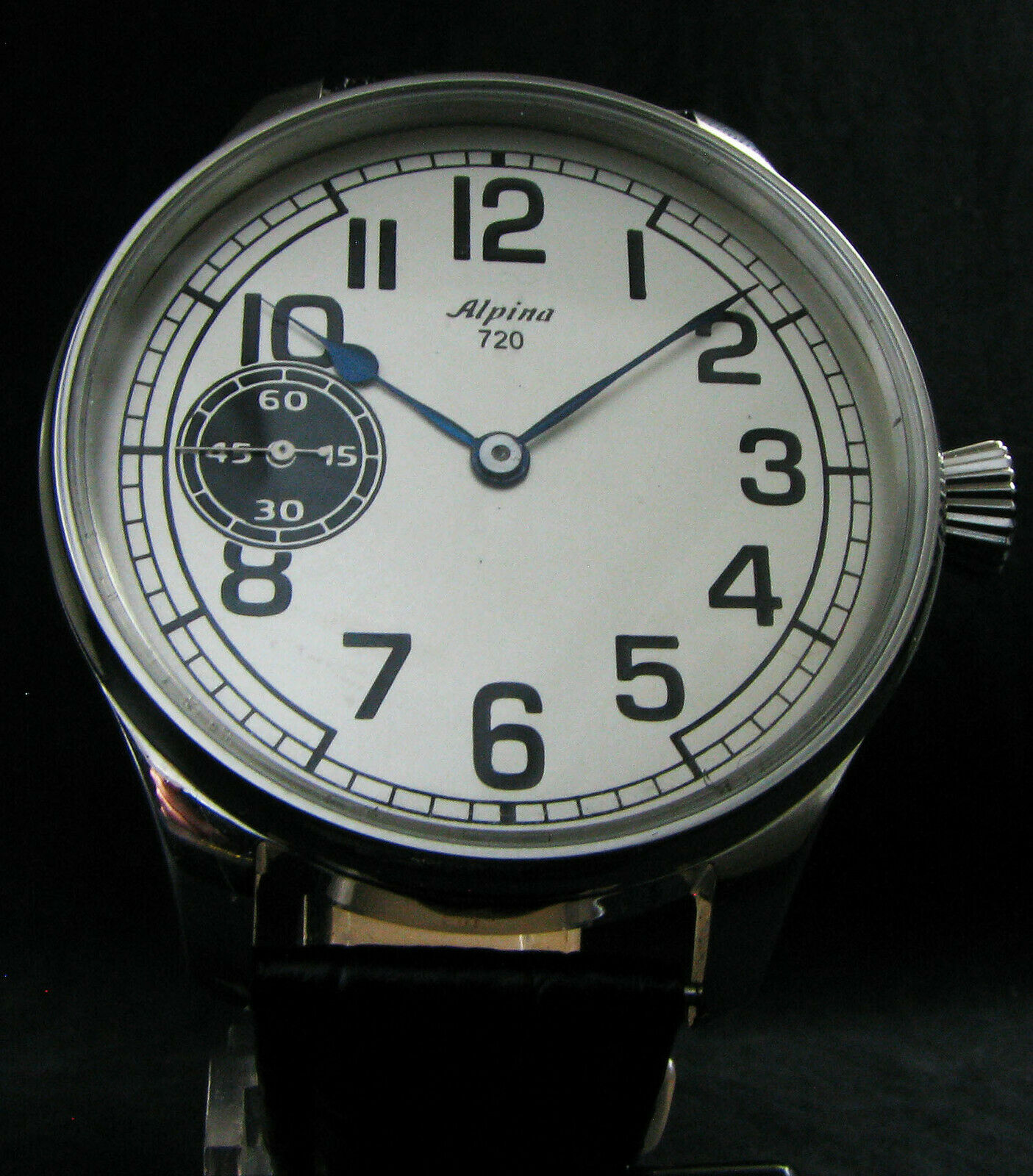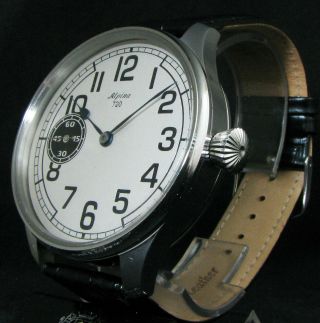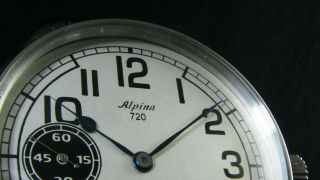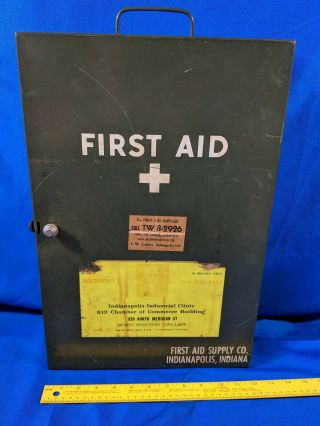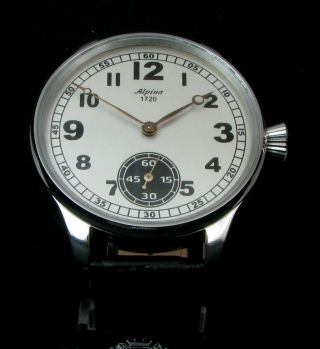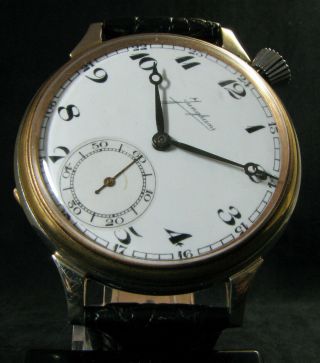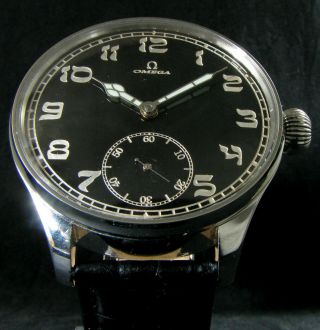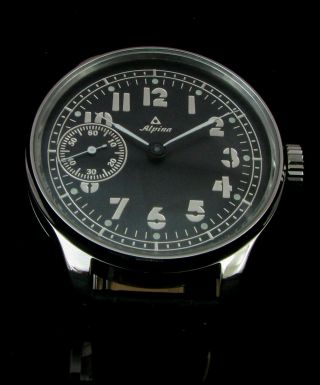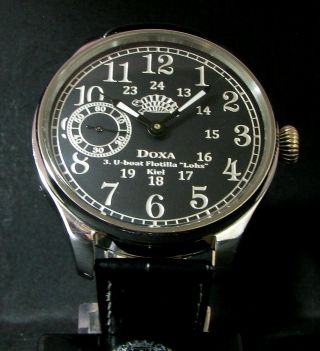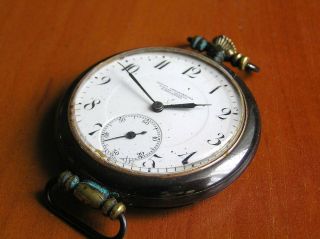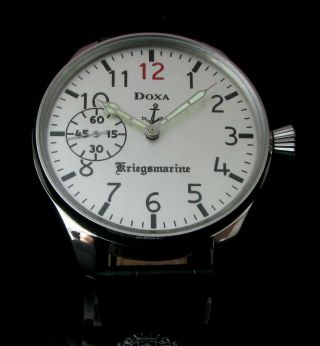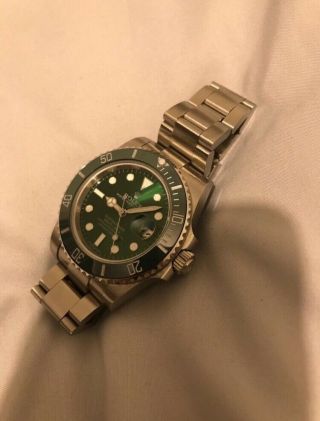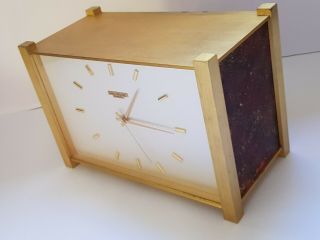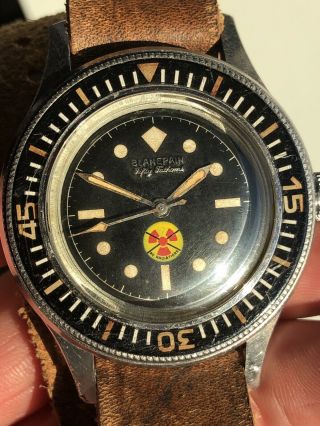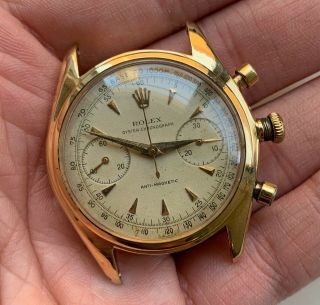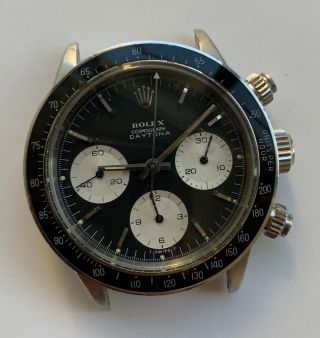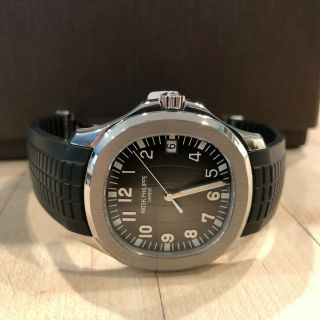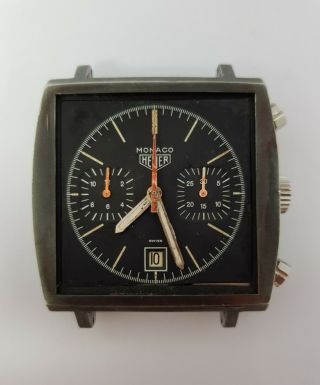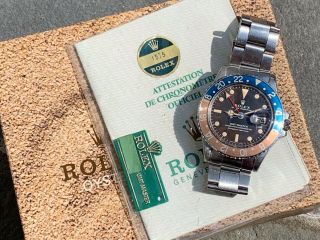ALPINA 720 UNION HORLOGERE Antique WWII Era Large Steel Wristwatch Hi - Grade
Item History & Price
| Reference Number: Avaluer:19336171 | Brand: ALPINA |
| Country Made: Switzerland | Case Material: Metall |
| Movement: MECHANICAL |
We offer you a rare wrist watch timepiece that dates circa 1930-40's.
DIAL: This gorgeous, men’s watch is a very handsome specimen and features NEW ENGRAVED METAL DIAL with arabic numbers, ORIGINAL blue steel HANDS. Have inscription "ALPINA 720".
The lugs are in great condition while the original pristine winding crown is in very good shape and operates proper...ly.
CASE: Mineral glass on the front and on the back.
CASE: New custom made Three-pieces chromoplated steel case is in excellent condition. Have exhibition snap back.
MECHANISM: UNION HORLOGERE signed. Working very good. This watch is have 15 ruby jewels on the movement, is in perfect working order and in excellent-very good cosmetic condition.
This beautiful antique wristwatch has the original movement in an excellent status which was very well saved, considering age of this watch. Mechanism has been recently serviced to ensure it winds and sets smoothly while keeping great, accurate time.
ABOUT WATCH: EXCELLENT working, rare, vintage and collectible. EXCELLENT cosmetic condition.
MEASURES:
Size (from lug to lug): 56 mm
Case Wide (with crown): 53 mm
Case Wide (without crown): 47 mm
Watch crystal size: 43 mm
Thickness: 13 mm It is in perfect working order and in EXCELLENT cosmetical condition.
It is comes with a new 22mm leather strap.
Alpina Watch History:
In 1883, Gottlieb Hauser and a number of manufacturers, in order to simplify purchasing and sales of watch parts, established the VUA (Vereinigte Uhrmacher Alpina), along with UH (Union Horologиre), with the establishment of the Alpina factory from Duret & Colonnaz in Geneva. The US manufacturers Gruen and Hamilton joined in 1905. The Alpina Union Horologиre opened up a factory in Glashьtte in 1909, called the Precisions-Uhrenfabrik Alpina (Precision Watch Factory Alpina).
The company was broken up in 1917 for political reasons (had to do with the war going on...).
Now, the Swiss side largely ended up as Rolex, but the German side was reformed in 1946 and ended up in 1949 as Dugena, which is an acronym for "Deutsch Uhrmacher-Genossenschaft Alpina".
So, where does this leave this watch? Near from the time period between 1909 and 1917, as the German branch post-1917 was called ADUG, with no Alpina in the name.
Alpina - since 1883.
The first horological cooperation.
Everything started in 1883 when Gottlieb Hauser, watchmaker in Winterthur, founded the Swiss Watchmakers Corporation ("Corporation d'Horlogers Suisse"). A number of watchmakers joined to purchase watch components and organized their manufacturing. Quickly, the new concept gained acceptance. Together with qualified manufactures, the Association started to develop its own calibres and to enlarge its distribution network. Ebauches (the base of a calibre) were produced by the Alpina Ebauche Factory in Geneva, owned by Duret & Colonnaz, which played also an important role in the construction of the first Alpina calibres. Final steps in the manufacture of the calibres were performed in Bienne, the place of the head quarters of the Association as of 1890. Success was swift and representations were set up in Germany as well as in East and Northern Europe. In 1901, the name "Alpina" was registered as a mark at the same time; it would only appear on the dials of high-end watches. From the beginning, Alpina watches were manufactured with high quality components, amongst others Brequet spirals, balance wheels with gold screws and heavy gold cases.
Alpina Glashütte 1909-1922.
In order also to participate in the German watch-manufacturing base, Alpina Union Horlogère founded the "Präcisions-Uhrenfabrik Alpina" in Glashütte in 1909. The Union's factories were now located in Geneva, Bienne, Besançon and Glashütte. In 1912, the first Alpina Chronometer Glashütte was finalized: it was equipped with an Alpina manufactured chronometer ebauche with a Glashütte escapement instead of the typical Swiss anchor escapement. The dial of these watches red "Präcisions-Uhrenfabrik Alpina Glashütte i.S.". Another model was created in 1913: it was a 21'' marine watch, which was purchased by the German navy at the time. Alpina Glashütte watches gained ground and competed directly with those of Lange & Söhne. In 1913, Lange & Söhne felt threatened and started a court case to try to stop Alpina on the ground that not all parts were manufactured in Glashütte. The court case dragged on for years but was finally proven without merit. It was dropped in favor of Alpina in 1915. Meanwhile World War I had started and had a stifling effect on the "Präcisions-Uhrenfabrik Alpina" in Glashütte. Parts could hardly be send to the factory from Switzerland due to war import restrictions. Further, there were major capital flow restrictions.
The First World War.
During the First World War, the Allied Forces were obviously not pleased with business relationships between Switzerland and Germany. The Alpina Glashütte factory had experienced already major problems but also the relationships between the Swiss Alpina factories and their customers in Germany were under strong pressure. Finally in 1917, towards the end of the first World War, the Association "Union Horlogère" was dissolved formally. Two separate anonymous societies were incorporated: the Union Horlogère SA in Bienne, Switzerland and the Alpina Deutsche Uhrmacher-Genossenschaft G.m.b.H. in Berlin, Germany. The branch, which was in charge of Swiss members, incorporated itself as yet a third separate association in the name of "Alpina Association des Horlogers Suisses". Activities of the companies surged dramatically after the First World War. Alpina watches were being sold with great success in 2000 retailers around Europe, from Lisbon to Copenhagen to Moscow.
How did the "Union Horlogère" operate ?
All representatives of Union Horlogère depended on the Association, which aims to sell high quality watches primarily under the Alpina brand. Each watchmaker, manufacturer or specialized shop that wanted to become a member had to apply. The Board of Directors of the Union Horlogère would study the candidature carefully and thereafter accept or reject it. One became a member after paying the entry fee. Membership allowed each representative to benefit from the purchase of Alpina watches at interesting prices as well as many other benefits described below.
The Association struggled hard for its members' interests and helped to stimulate maximum growth. The Association was a non-profit organization. Each member was guaranteed to be the only Alpina representative in his or her town with the exception if the town was large enough to support more than one representative. Members could represent other brands, but could not be member of a similar organization. The Association fixed retail prices and members were bound to maintain the set prices to avoid unconstructive discounting. Advertising on Alpina watches was entirely paid the Association from its common funds coming from subscriptions, entry fees and subsidies calculated on suppliers' turnover. As of 1908, the Association created a guarantee, which was valid in all shops selling Alpina watch in the Swiss network. Then in 1926, this guarantee became valid internationally. Retailers could make use of a decorator to help them realize attractive windows. The Association organized selling and technical training courses regularly. Lastly, the Association published its own newspaper informing its members on developments and novelties
The regular Committee primarily directed the Association. The Committee would meet several times a year to review new applications, the discuss disputes between members, to determine the contents of the new catalogue, its cost, the amount of participation, etc. The main event without any doubt was the yearly Congress, a kind of mini fair for two days with a great atmosphere: Alpinists coming from all over the world were invited to discover the new products and order in advance. The Congress was a social event where members could share their problems and experiences, and also form strong long-term friendships. Alpinists formed a great family, ready to support its members during the good and the bad times.
The Alpina Gruen Gilde 1929-1937.
The smooth and successful operation of the Alpina Union Horlogère provoked other brands' interest. The American brand Gruen, from Cincinnati, wished a merger with Alpina in order to use its European distribution network. In 1929, the "Alpina Gruen Gilde SA" is born, the largest community of interests that ever existed in the horological field. The factories belonging to the new company were rationalized to produce standard calibres, and quality of Alpina and Gruen watches improved. Highlight model created at this time is the "Doctor's Watch" produced by the Aegler factory. Rolex later bought the Aegler factory. The "Doctor's Watch" was distributed under the names of Alpina, Gruen, Alpina-Gruen and Rolex ("Prince"). But the infatuation of the beginning had a short duration. Even when Gruen produced good quality watches, it was almost unknown in Europe. Moreover Gruen wanted to sell its watches at higher prices than Alpina, which made it very difficult for the European Association members to accept Gruen. At the same time, Gruen seemed to have restricted Alpina access to its USA members. Heavy losses were the result of this co-operation, and the two brands separated in 1937; Alpina Union Horlogère SA continued alone.
Alpina's best sellers.
In 1933, Alpina presented its first "sports-watch", the "Blockuhr" in steel. During this time, Alpina patented also a new type of crown (Brevet 1464). Thanks to the technical progress, the sports-watch evolved quickly and became the "Alpina 4" in 1938. The "4" meant a combination of four major qualities of an Alpina sports-watch: 1) anti magnetic, 2) waterproof (thanks to its "Geneva" case), 3) equipped with the Incabloc anti-shock system, and lastly, 4) stainless steel. The 'Alpina 4' was manufactured with the Alpina self-winding calibre 592, one of the strongest calibres of its generation. This calibre was later on used to equip further sport-models such as the Alpina 70 (1953), the Standard (1958) and the Tropicproof (1968). In 1945, the first Alpina automatic movement was realized, the 582 calibre. The automatic winding system worked with a mechanism with two springs where in between the oscillating mass moved back and forth. This large and accurate movement (12 ½ lines) was equipped with a Nivarox spiral, had 18 000 alternances and the Incabloc system. Its power reserve was 40 hours. In 1957, the Alpina President was introduced and quickly became known as a reliable automatic sport-watch (calibre 584c with date).
In 1963, Alpina realized an automatic movement for women; the smallest and strongest ever made yet, the calibre 362 (6 ½ lines). It worked with a rotor system, turning in both ways. Those are few of the most known models. The Alpina collection at its height consisted of many hundreds of models (there were 1000 models exhibited at the 1958's Congress). Retrospectively, one can say that the sports-line was the main focus of the Alpina collection. Since 1933, Alpina improved the performance of its sports-watches continuously and followed with these watches an evolution where people engaged in more spare-time activities.
The Second World War.
While the Union Horlogère had separated in three legally independent companies during the First World War, relationships were again under intense scrutiny during World War II. Import and capital flow restrictions as well as travel problems suppressed many of its activities. Eventually, the Allied Forces pressed the Swiss Alpina Union Horlogère to drop usage of the Alpina name in Germany. The German association then adopts the name Dugena (Deutsche Uhremacher-Genossenschaft Alpina), which becomes their new mark.
After the war.
After the War, co-operation re-started intensively. The change of the name in Germany to Dugena even had a positive effect because members could now also start to sell watches produced in Germany. The Swiss Union Horlogère sold again only high-end watches from Switzerland to its members, including the German association under the strong Alpina brand. Alpina continued to develop and the Congress reconciled each year with more and more people. Everything ran well until the seventies, when the quartz crises violently crushed the Swiss watch-industry. Alpina was powerless to counter the overwhelming emergence of electronic watches. Other major brands got together to form groups (predecessor of the Swatch Group), but Alpina tried to fight it alone without really succeeding. In 1972, Alpina Watch International SA was incorporated with new German investors, which purchased all shares in Alpina Union Horlogère SA. A few years later, the German investors settled the company in Köln, Germany. Alpina continued to be sold in a more restrictive manner under the new slogan that determined more clearly the commercial policy of the brand: "Alpina the brand reserved to specialized dealers". Watches were now sold partly from Köln, further diluting the clarity of the company. Much of the previous 'Alpinist' spirit that made Alpina so strong was getting lost. Product creation and renewal was managed partly from the distribution company in Germany resulting in less than coherent collections that had reduced market appeal. Alpina missed the revival of the mechanical watch in the eighties and nineties, probably due to fact that the German investors behind Alpina watch International SA were too far away from the epicentre of mechanical watch making in Switzerland. Still however, some of the 'Alpinists' are meeting per today in an informal annual gathering. It is a clear objective for the new Alpina to recapture the Alpinist spirit that made Alpina so strong in the past. Watches are being sold per today in only approximately 30 shops in Germany.
Thank You For Bidding and Good Luck!
Recommendations for the owner of antiquarian watches: All Antique watches are mechanical. Many repairs will not be cheap, as most likely they will require replacement of non-standard parts (unlike most late model watches).
- Antique watches should not be beaten or dropped - because repairs may be expensive.
- Antique watches are generally NOT waterproof. This is because waterproofing was not in general production until the middle of the 20th century for most watches. Therefore you should protect your antique watch from exposure to moisture.
- If your watch becomes wet it should be dried off quickly. Carefully open all covers and use a hair drier to blow dry the movement, dial, covers, crown. This will reduce the amount of rust.
- If your watch becomes wet with any kind of salt water you should immediately immerse or spray your watch with fresh (no-salt) water to remove all the salt from the works before drying the watch completely. Any salt left in the watch will combine with moisture in the air to rust metal components of the movement, case etc.
- Winding any mechanical watch tight may break the mainspring. If you can avoid it do not wind the watch hard.
- When adjusting the hands of your watch, move them in a clockwise direction only. Counter-clockwise adjustments may damage the movement.
- If you must adjust counter-clockwise make it for small adjustments only (i.e. for minutes, NOT hours).
- Be careful and gentle when adjusting the movement speed (faster or slower). Don't make sharp movements, and don't touch other components in the movement especially the pendulum mechanism.
- Every 2-3 years it is necessary to service and oil vintage watches.
- IF the watch is dirty - allow the watch to run down, don't wind it again until you have it serviced by a qualified watch repair expert. Dust will absorb and remove important lubricants and cause the movement pieces to wear down.
- To clean the case, dial and crystal you should use a cloth that does NOT leave fibers as these may get caught up in the movement. Check with your Watch repair expert to get an appropriate cloth.
- Keep your antiques watch away from magnets. Strong magnetic fields may affect the accuracy of your watch since some vintage watches were made with iron based components in the movement.
- Most Cases and Covers are fine components and will not handle abuse well. The watch should not be shaken, beaten, or stressed.
- Antique watches generally experience an error of up to 5-7 minutes a day. Any accuracy of +- 5 minutes is very good.PLEASE READ THE FOLLOWING BEFORE BIDDING: Vintage watches are very delicate and I package to the highest degree to prevent damage.
High altitude flights can be hard on watches due to extreme temperature changes. This can cause the oil viscosity to decrease (gum up) and prevent a watch from ticking (the balance moving freely etc.). It may need to be oiled when it arrives regardless of its recent servicing (if applicable). Although this is only a very slight possibility it can occasionally happen.
Please bear in mind that you are buying a used watch and it will require service at some point in time.Free Shipping WorldWide Including Insurance.
Worldwide shipping usual takes 10-14 working days. Some times little more.
Shipping to Canada and Germany by registered air mail 30 USD, (Recommended).
I accept Payments via: Paypal.
Return Policy:
1. We always honor a 7-day return on our items, and guarantee them to be as described.
2. Money back, so ask questions if necessary. We're easy to deal with. If you are in any way unsatisfied with the watch I will refund the purchase price. If you recieved watch damage or you have any other problems with my watch plase contact us via e-mail before leaving feedback. We are gladly assist you.



